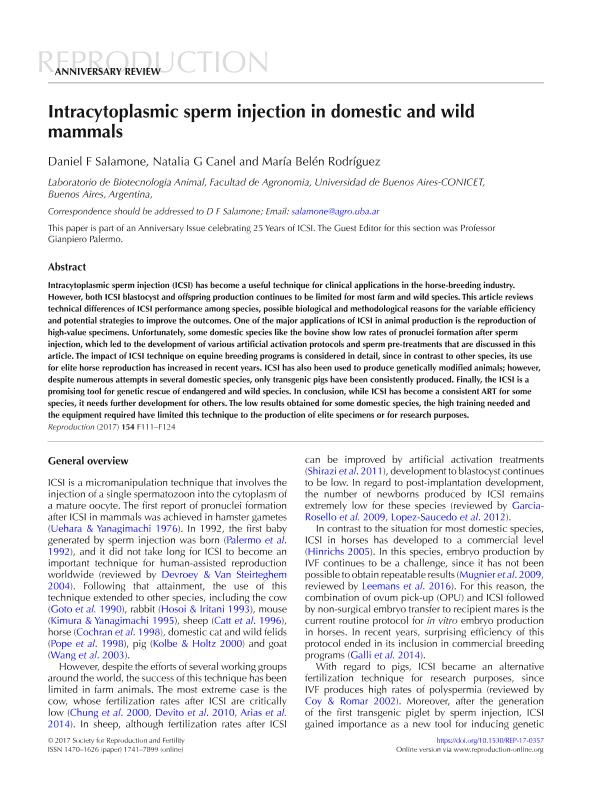Mostrar el registro sencillo del ítem
dc.contributor.author
Salamone, Daniel Felipe

dc.contributor.author
Canel, Natalia Gabriela

dc.contributor.author
Rodriguez, Maria Belén

dc.date.available
2021-04-19T02:21:34Z
dc.date.issued
2017-12
dc.identifier.citation
Salamone, Daniel Felipe; Canel, Natalia Gabriela; Rodriguez, Maria Belén; Intracytoplasmic sperm injection in domestic and wild mammals; Elsevier; Reproduction; 154; 6; 12-2017; F111-F124
dc.identifier.uri
http://hdl.handle.net/11336/130254
dc.description.abstract
Intracytoplasmic sperm injection (ICSI) has become a useful technique for clinical applications in the horse-breeding industry. However, both ICSI blastocyst and offspring production continues to be limited for most farm and wild species. This article reviews technical differences of ICSI performance among species, possible biological and methodological reasons for the variable efficiency and potential strategies to improve the outcomes. One of the major applications of ICSI in animal production is the reproduction of high-value specimens. Unfortunately, some domestic species like the bovine show low rates of pronuclei formation after sperm injection, which led to the development of various artificial activation protocols and sperm pre-treatments that are discussed in this article. The impact of ICSI technique on equine breeding programs is considered in detail, since in contrast to other species, its use for elite horse reproduction has increased in recent years. ICSI has also been used to produce genetically modified animals; however, despite numerous attempts in several domestic species, only transgenic pigs have been consistently produced. Finally, the ICSI is a promising tool for genetic rescue of endangered and wild species. In conclusion, while ICSI has become a consistent ART for some species, it needs further development for others. The low results obtained for some domestic species, the high training needed and the equipment required have limited this technique to the production of elite specimens or for research purposes.
dc.format
application/pdf
dc.language.iso
eng
dc.publisher
Elsevier

dc.rights
info:eu-repo/semantics/openAccess
dc.rights.uri
https://creativecommons.org/licenses/by-nc-sa/2.5/ar/
dc.subject
ICSI
dc.subject
Equine
dc.subject
Embryos
dc.subject
OPU
dc.subject.classification
Tecnología GM, clonación de ganado, selección asistida, diagnósticos, tecnología de producción de biomasa, etc.

dc.subject.classification
Biotecnología Agropecuaria

dc.subject.classification
CIENCIAS AGRÍCOLAS

dc.title
Intracytoplasmic sperm injection in domestic and wild mammals
dc.type
info:eu-repo/semantics/article
dc.type
info:ar-repo/semantics/artículo
dc.type
info:eu-repo/semantics/publishedVersion
dc.date.updated
2021-04-06T18:40:45Z
dc.identifier.eissn
1741-7899
dc.journal.volume
154
dc.journal.number
6
dc.journal.pagination
F111-F124
dc.journal.pais
Reino Unido

dc.journal.ciudad
Cambridge
dc.description.fil
Fil: Salamone, Daniel Felipe. Universidad de Buenos Aires. Facultad de Agronomía. Pabellón de Zootecnica. Laboratorio de Biotecnología Animal; Argentina. Consejo Nacional de Investigaciones Científicas y Técnicas; Argentina
dc.description.fil
Fil: Canel, Natalia Gabriela. Universidad de Buenos Aires. Facultad de Agronomía. Pabellón de Zootecnica. Laboratorio de Biotecnología Animal; Argentina. Consejo Nacional de Investigaciones Científicas y Técnicas; Argentina
dc.description.fil
Fil: Rodriguez, Maria Belén. Universidad de Buenos Aires. Facultad de Agronomía. Pabellón de Zootecnica. Laboratorio de Biotecnología Animal; Argentina. Consejo Nacional de Investigaciones Científicas y Técnicas; Argentina
dc.journal.title
Reproduction

dc.relation.alternativeid
info:eu-repo/semantics/altIdentifier/url/https://rep.bioscientifica.com/view/journals/rep/154/6/REP-17-0357.xml
dc.relation.alternativeid
info:eu-repo/semantics/altIdentifier/doi/http://dx.doi.org/10.1530/REP-17-0357
Archivos asociados
